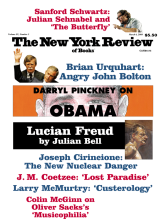In response to:
At the Heart of the Terror from the December 20, 2007 issue
To the Editors:
According to Colin Jones [“At the Heart of the Terror,” NYR, December 20, 2007], Dickens was referring to the start of the French Revolution when he wrote, “It was the best of times, it was the worst of times.” Not so. Two paragraphs later Dickens tells us that his topic is “the year of Our Lord one thousand seven hundred and seventy-five.”
Jonathan Bennett
Bowen Island, British Columbia
Colin Jones replies:
Jonathan Bennett is correct to point out the sequence of the text in the opening chapter of Dickens’s A Tale of Two Cities. However, it seems safe to assume that Dickens’s opening words have a wider frame of reference. The title of the first chapter is “The Period,” and the year 1775 is the midpoint between the chronological limits of the novel (1757 and 1793). The chapter refers to events both before that pivotal year (e.g., Joanna Southcott’s prophesies) and after it (e.g., “tumbrils of the Revolution,” plus the invention of “a certain movable framework with a sack and a knife in it, terrible in history”). “All these things, and a thousand like them,” Dickens concludes the chapter, “came to pass in and close upon the dear old year” 1775 (my italics). Finally, “the best of times, worst of times” phrasing seems especially and poignantly apt for the novel’s very last chapter, as a tumbril bears the selfless Sydney Carton to the guillotine at the height of the Terror.
If this correspondence has the merit of encouraging readers to go back to Dickens’s wonderful novel it will have served a purpose. A collection of essays, Charles Dickens, A Tale of Two Cities and the French Revolution, which I have coedited with Josephine McDonagh and Jon Mee, will be published by Palgrave Macmillan later this year.
This Issue
March 6, 2008



